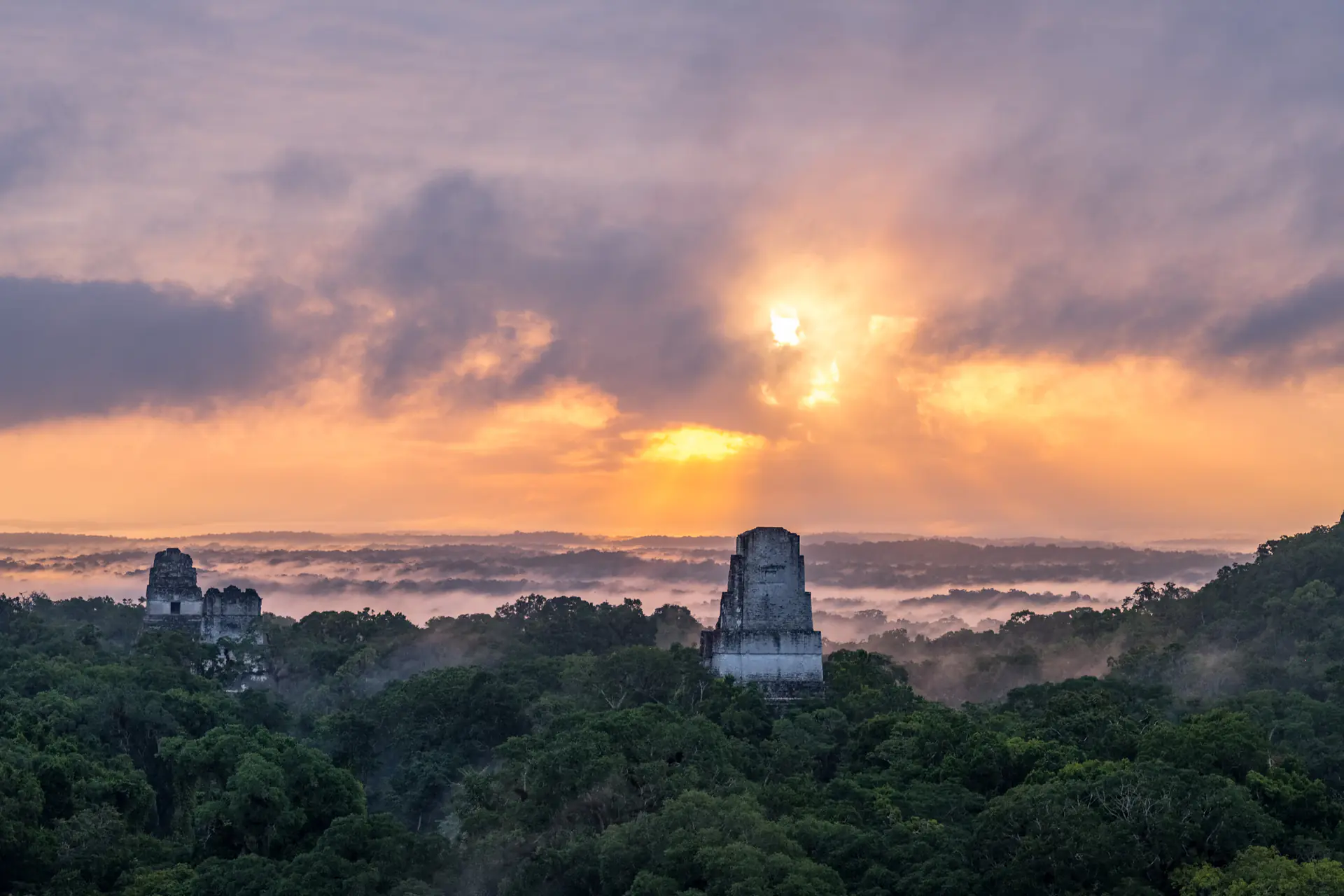
Tikal National Park: Maya Pyramids, Temples & Wildlife
Ancient Maya City in Guatemala's Rainforest
About This Site
Maya architects constructed Tikal between 200-900 CE in Guatemala's remote Petén rainforest, building massive limestone pyramids reaching 70 meters above dense jungle canopy to create one of civilization's greatest urban centers housing 100,000 inhabitants at its peak. The city dominated Maya politics for centuries through 33 documented rulers whose hieroglyphic inscriptions chronicled 1,161 years of history spanning 292 BCE to 869 CE. Temple IV rises 64.6 meters as the tallest Pre-Columbian structure in the Americas, while Temple I's distinctive roof comb and the ceremonial Great Plaza demonstrate architectural mastery rivaling any ancient culture. This 1979 Mixed UNESCO World Heritage Site protects both archaeological treasures and 57,600 hectares of pristine tropical forest.
Why It Matters
Tikal represents the zenith of Classic Maya civilization through monumental architecture including the Americas' tallest Pre-Columbian structure, sophisticated urban planning housing 100,000 inhabitants, and 1,161 years of documented dynastic history. The site protects critical biodiversity across 57,600 hectares of Maya Forest, harboring over 330 bird species and five cat species including jaguars.
Planning Your Trip
Essential information for visiting this destination
Getting There
Mundo Maya International Airport at Flores provides the primary gateway, receiving domestic flights from Guatemala City (45 minutes, $200 USD round-trip) operated by Avianca and TAG Airlines. For budget travelers, overnight buses from Guatemala City (550 kilometers) operated by Línea Dorada and ADN cover the journey in 8-10 hours, arriving at Flores or Santa Elena. From Flores, tourist shuttles depart multiple times daily for the 65-kilometer journey to Tikal, requiring 90 minutes via well-maintained roads through Petén jungle. Private drivers and rental cars offer flexibility for exploring surrounding sites. Most organised tours include round-trip transport from Flores hotels. The park entrance sits 2.5 kilometers from the main plaza, with a complimentary shuttle operating until 15:00.
Where to Stay
Flores island town offers the widest accommodation selection, with budget hostels, mid-range hotels, and boutique establishments surrounding the colonial-era church plaza. The lakeside setting provides atmospheric evenings with rooftop restaurants. The 65-kilometer distance from Tikal enables early morning departures for sunrise access. Jungle lodges within Tikal National Park including Jungle Lodge Hotel, Hotel Jaguar Inn, and Hotel Tikal Inn place visitors inside the archaeological zone for exclusive sunrise access. These establishments enable evening wildlife encounters, though isolated locations mean premium pricing. El Remate village 30 kilometers from Tikal offers tranquil eco-lodges along Lake Petén Itzá's northern shore, providing middle-ground between Flores and jungle lodges. Properties feature natural settings with lake swimming and lower costs.
Where to Eat
Petén regional cuisine showcases distinctive Guatemalan flavours through specialities like pepián (spicy meat stew with pumpkin seed sauce), kak'ik (traditional turkey soup with achiote and coriander), and jocon (chicken in green tomatillo and coriander sauce). Flores restaurants including Los Amigos, Cool Beans Cafe, and Restaurante Típico Imperio serve authentic Guatemalan dishes using local ingredients. Tortillas, black beans, and rice form ubiquitous accompaniments, while tropical fruits provide refreshing desserts. Grilled meats feature prominently at Los Charly's near the causeway. No food vendors operate inside Tikal National Park, requiring visitors to pack lunches and snacks. Vegetarian options exist at Secret Garden within Los Amigos Hostel.
Things to Do
Tikal entrance costs GTQ 150 ($20 USD) for standard admission (6am-5pm), available at park entrance with passport required. Sunrise tickets cost GTQ 250 ($32 USD) including 4-8am access, requiring mandatory certified guide (GTQ 400-500 / $52-65 USD). Certified guides cost GTQ 400-500 ($52-65 USD) for 4-hour group tours explaining hieroglyphics, dynastic history, and spotting wildlife visitors miss independently. Private guides cost GTQ 600-800 ($78-104 USD). Sunrise tours from Flores hotels depart 2-3am, costing $45-75 USD including transportation, guide, and entrance. Day tours from Flores cost $25-45 USD. Nearby Yaxhá archaeological site costs GTQ 80 ($10 USD), offering twin lake views and fewer crowds. Multi-day packages combining Tikal with Yaxhá cost $85-120 USD, while El Mirador expeditions require 5-7 day jungle treks costing $400-600 USD accessing La Danta pyramid.
Travel Essentials
Comprehensive travel insurance covering medical care and emergency evacuation proves essential for Guatemala travel, particularly given remote jungle location and basic medical facilities in Flores. Travel eSIM data plans from providers like Holafly or Airalo enable navigation throughout Guatemala without expensive roaming charges. Guatemala uses Type A and Type B electrical outlets at 120V. Petén's tropical climate demands lightweight clothing, though long trousers protect against insects and sun. Sturdy hiking shoes with ankle support navigate uneven pathways and temple steps. Pack 2-3 liters water per person--no vendors operate inside the park--alongside snacks and lunch. High-SPF sunscreen and DEET-based insect repellent protect against sun and mosquitoes. Hat and sunglasses prove indispensable. Arrive at opening (6:00) for coolest temperatures and best wildlife viewing.
Loading map...
Visitor Information
Everything you need to know for your visit
What to Bring
Passport (required for entry), 2-3 liters water per person (no vendors inside park), packed lunch and snacks, strong DEET insect repellent, high-SPF sunscreen, sturdy hiking shoes with ankle support, wide-brimmed hat, cash for entrance fees, binoculars for wildlife viewing, raincoat during rainy season, offline maps. Pack out all waste--no bins inside park.
Accessibility
Wheelchair accessibility remains extremely limited throughout Tikal due to challenging jungle terrain featuring uneven limestone pathways, exposed tree roots, and steep pyramid stairways requiring climbing ability. A complimentary shuttle operates from park entrance to main plaza area until 15:00 daily, though temples themselves remain inaccessible. Ground-level viewing of monuments possible with advance coordination through park management.
Safety Tips
Always remain on designated marked trails and maintain safe distance when observing wildlife--jaguars, pumas, and venomous snakes inhabit the forest. Bring 2-3 liters water per person as severe dehydration risk exists in tropical heat with no water available inside park. Apply high-SPF sunscreen and DEET insect repellent regularly. Tourist police (DISETUR) patrol regularly providing security, though visitors should remain alert in remote temple areas.
Experiencing Tikal's Archaeological Wonders

Temple I - Temple of the Great Jaguar
The iconic forty-seven-meter funerary pyramid dominates the Great Plaza's eastern edge, its distinctive roof comb piercing the jungle canopy. Built circa 732 CE by Jasaw Chan K'awiil I, the nine stepped levels symbolise the nine Maya underworld levels (Xibalba). Though climbing is prohibited, viewing from the plaza reveals perfect proportions showcased by steep stairways and carved hieroglyphs. The tomb within contained jade, obsidian, shells, and pearls. Early morning light illuminates the eastern face magnificently while howler monkey calls create atmospheric connection to ancient glory. Pro tip: Photograph Temple I from the North Acropolis platform (opposite side of Great Plaza) around 7-8am when morning light illuminates the eastern face perfectly--this elevated angle captures the full height and roof comb without crowds blocking ground-level views.
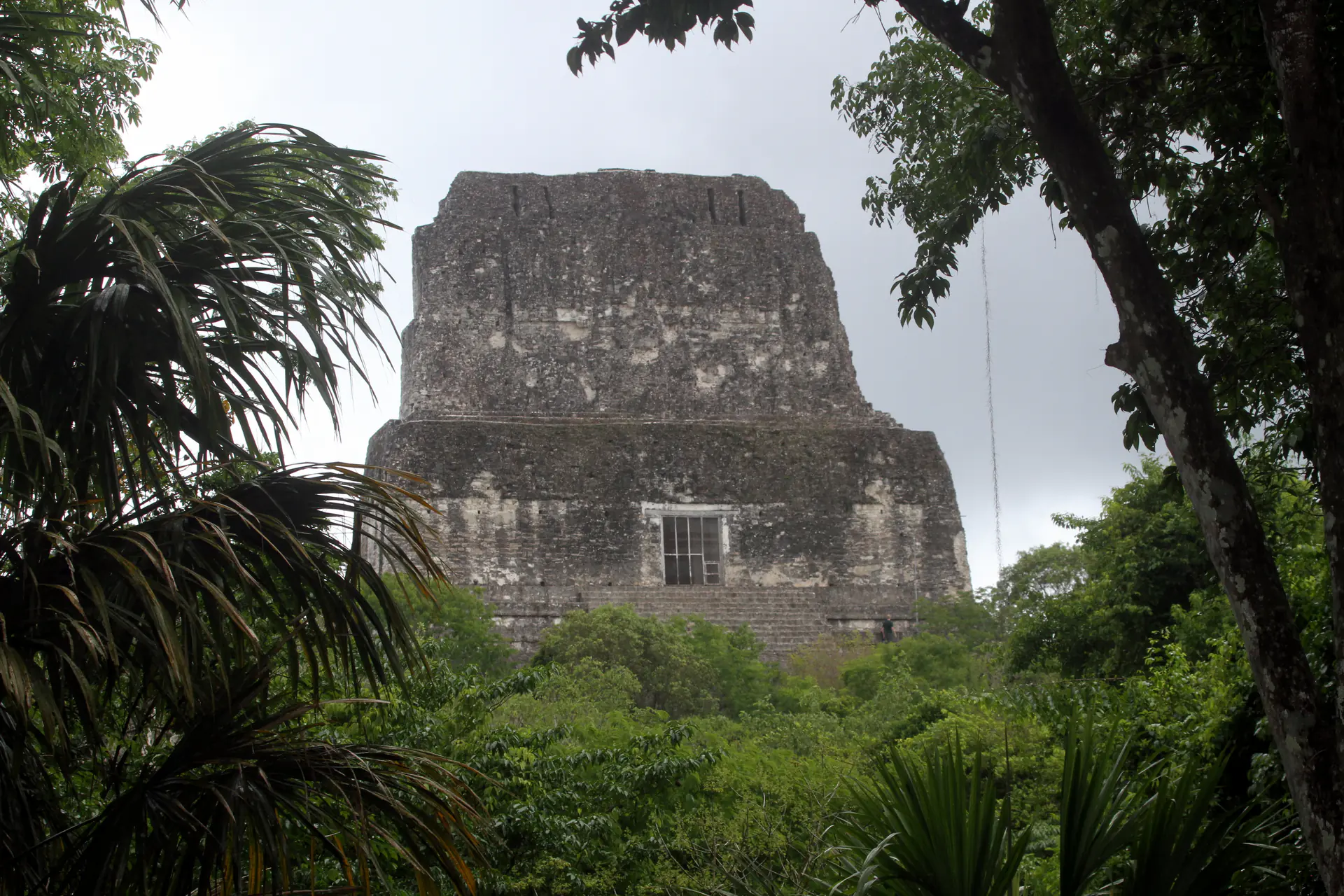
Temple IV - Tallest Maya Structure
At 64.6 meters from platform to roof comb summit, Temple IV stands as the tallest structure ever built by ancient Maya civilization. This massive 8th-century pyramid requires ascending wooden stairs through jungle-covered mound to reach viewing platforms. The summit rewards climbers with spectacular 360-degree views across jungle canopy, with Temples I, II, and III visible as roof combs emerging from endless green. Sunrise provides Tikal's most magical experience--arriving in darkness, visitors witness jungle awakening as howler monkeys roar. Pro tip: Arrive at Temple IV by 5:30am for sunrise (requires special sunrise ticket GTQ 250/$32 USD)--the 30-minute walk from entrance is safe with flashlight, and you'll witness spectacular jungle awakening as howler monkeys roar and mist reveals distant temple roof combs at dawn.
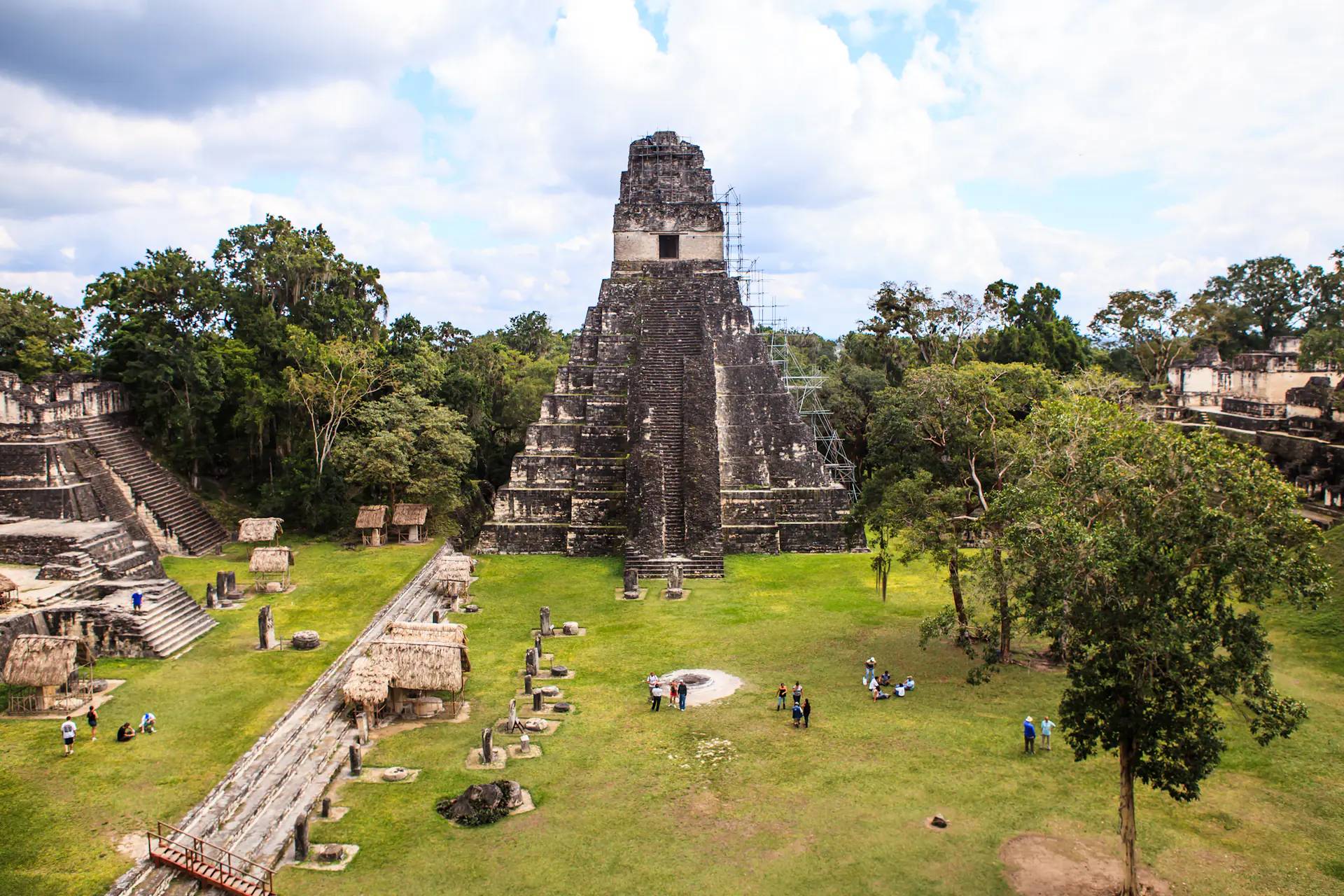
Great Plaza - Ceremonial Heart
The Great Plaza formed ancient Tikal's ceremonial epicentre, where rulers conducted rituals before assembled masses. Temple I rises along the eastern edge, facing Temple II to the west, while the North Acropolis anchors the northern boundary. The plaza witnessed coronations and ceremonies central to Maya political and religious life. By the 9th century, 43 stelae and 30 altars adorned the precinct, their hieroglyphs preserving dynastic records. Today, visitors traverse the same pavement ancient nobility walked, while howler monkeys occupy temple peaks. Pro tip: Spend 30 minutes sitting on the North Acropolis steps observing the Great Plaza around 9-10am--you'll watch wildlife activity (coatis, agoutis, ocellated turkeys) while tour groups pass through, giving you a contemplative experience of this sacred space impossible when rushing between temples.
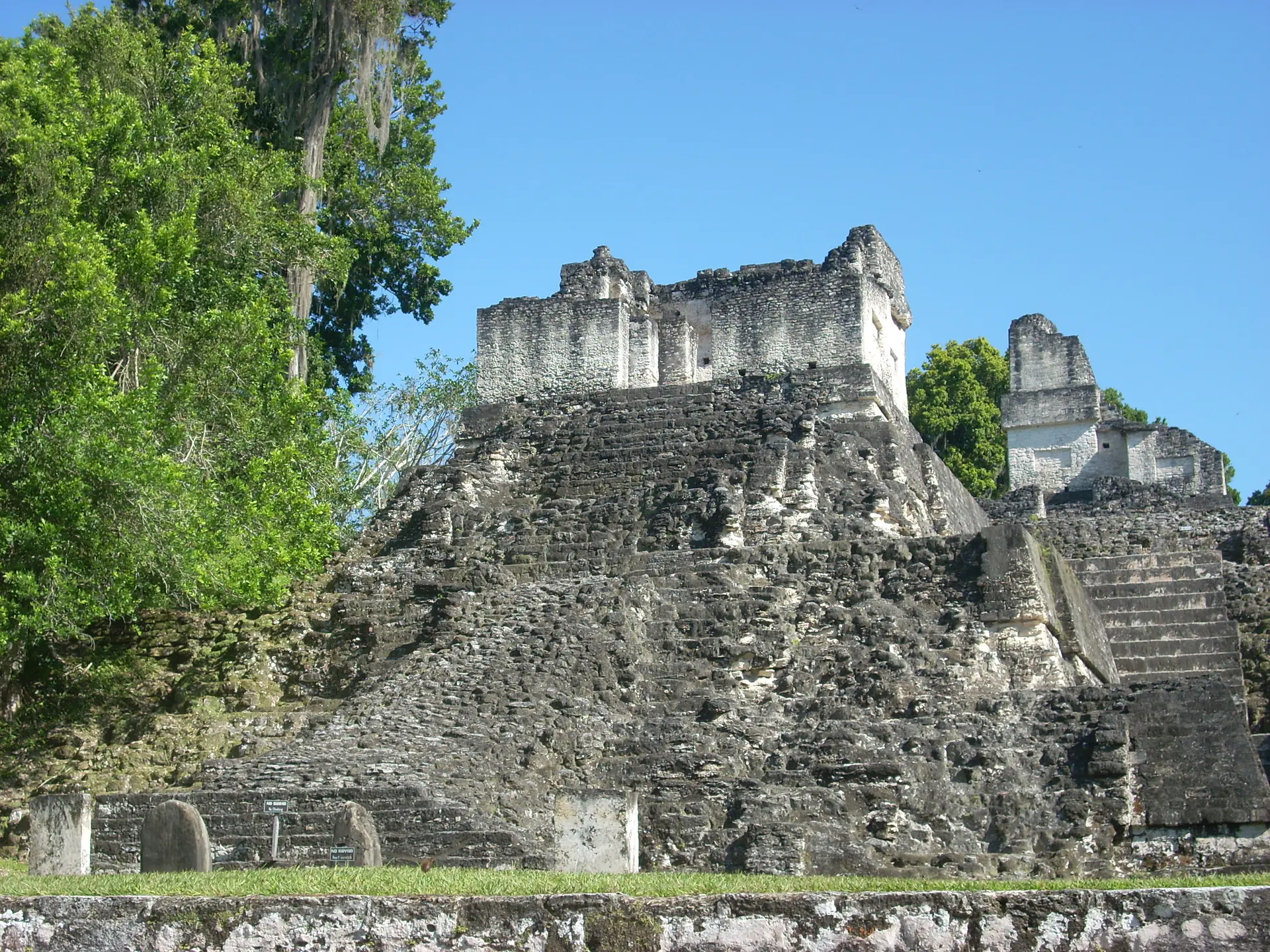
North Acropolis - Royal Necropolis
The North Acropolis served as Tikal's royal burial ground for over 1,500 years, containing elaborate tombs beneath successive temple constructions. This one-hectare platform, raised 12 meters above the Great Plaza, preserves remarkable records of Maya funerary practices. Eighteen stelae document dynastic succession, while excavations revealed tombs filled with jade, obsidian, and exotic goods. The multilayered construction--each generation building atop predecessors' monuments--created a time capsule of architecture. Stela 31 commemorates the 9.0.0.0.0 Bak'tun ending, providing insights into Tikal's political relationships with Teotihuacan. Pro tip: Examine the carved stelae along the North Acropolis base in late afternoon (3-4pm) when angled sunlight creates shadows that make the eroded hieroglyphs and royal portraits easier to see--morning light is too flat to reveal the weathered details on these 1,200-year-old monuments.
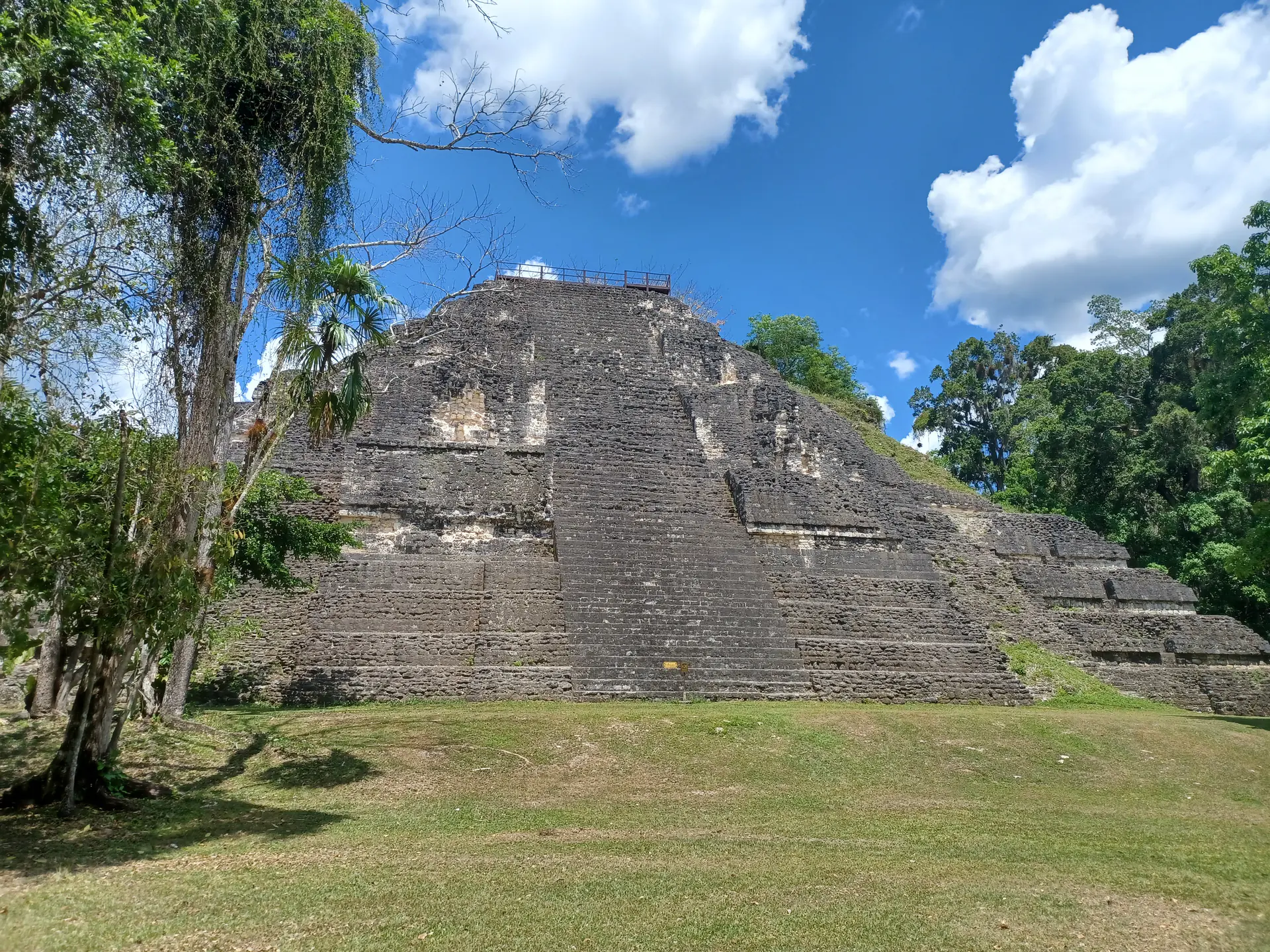
Lost World (Mundo Perdido) Complex
The Lost World complex represents Tikal's largest Preclassic ceremonial center, predating the Great Plaza's monuments by centuries. The massive central pyramid offers panoramic jungle views rivalling Temple IV, with stone steps rewarding climbers with 360-degree vistas. Mundo Perdido demonstrates architectural continuity from Preclassic through Classic periods. The complex's astronomical alignments reveal sophisticated knowledge of celestial cycles, with structures positioned to mark solstices and equinoxes. Visitors often find Mundo Perdido less crowded, enabling quieter contemplation while spider monkeys swing through trees. Pro tip: Visit Lost World (Mundo Perdido) around 11am-noon when most visitors concentrate at Great Plaza or Temple IV--you'll often have the pyramid summit entirely to yourself for 360-degree jungle photography, and spider monkeys are most active in midday canopy heat.

Jungle Wildlife Encounters
Tikal's 57,600 hectares of protected tropical forest teem with extraordinary wildlife, transforming the archaeological experience into a naturalist's paradise. Howler monkeys' territorial calls echo across the canopy from dawn, their deep roars audible kilometers away as troops defend feeding territories among temple peaks. Spider monkeys swing acrobatically through branches, occasionally pausing to observe human visitors below. Coatis forage in noisy groups along forest trails, their ringed tails held high. Toucans and scarlet macaws splash brilliant color against green foliage, while ocellated turkeys--iridescent ground birds found nowhere else--strut along pathways. Though jaguars and pumas inhabit the forest, these elusive cats remain rarely seen. Guided walks significantly enhance wildlife spotting, as experienced guides possess remarkable eyes for detecting camouflaged creatures.
Historical Context
Preclassic Settlement (600 BC-200 CE)
Maya people established Tikal around 600 BC, constructing first monumental architecture by 300 BCE. Early builders erected massive pyramids in the Lost World complex, demonstrating sophisticated engineering and astronomical knowledge. By 90 CE, legendary founder Yax Ehb Xook established the Yax Mutal dynasty.
Classic Period Dominance (200-900 CE)
Tikal reached its apogee during the Classic Period, growing into a sprawling metropolis of 50,000-100,000 inhabitants that dominated Maya lowland politics. Powerful rulers constructed monumental temples, conquered rival cities, and maintained diplomatic relationships to distant Teotihuacan. The 8th century represented Tikal's architectural zenith.
The Hiatus and Resurgence (562-734 CE)
In 562 CE, rival city Caracol defeated Tikal, initiating a 130-year hiatus of minimal monument construction. However, Jasaw Chan K'awiil I's 682 CE coronation marked Tikal's dramatic resurgence. In 695 CE, he defeated Calakmul in decisive warfare, restoring Tikal's supremacy and building Temple I.
Mysterious Collapse (869-950 CE)
Tikal's decline proved swift and enigmatic. The last monument, Stela 11, was erected in 869 CE, with the final dated inscription in 889 CE. By 950 CE, the great city lay deserted. Overpopulation, agrarian failure and prolonged drought likely triggered collapse. Rainforest reclaimed temples and plazas.
Rediscovery and Modern Conservation (1848-Present)
Governor Ambrosio Tut rediscovered jungle-covered Tikal in 1848. Guatemala established Tikal National Park in 1955, while University of Pennsylvania excavated monuments through the 1960s. UNESCO inscribed Tikal as Mixed World Heritage site in 1979. In 2018, LiDAR surveys revealed 60,000 previously uncharted structures.
Conservation
Current Status
Tikal maintains good conservation status since 1979 UNESCO inscription, with active restoration protecting archaeological structures and 57,600 hectares of tropical forest within the Maya Biosphere Reserve.
Challenges
- Wet tropical climate causes continuous weathering of limestone structures, requiring constant maintenance
- Jungle encroachment threatens buildings as tree roots damage foundations and vegetation covers monuments
- Mass tourism exceeding 200,000 visitors annually causes wear on pathways and structures
- Ongoing deforestation and agricultural encroachment in surrounding Maya Biosphere Reserve
- Limited resources for comprehensive site protection across vast unexcavated areas
Conservation Efforts
- Advanced stabilisation technologies and restoration methods implemented to preserve ancient structures using authentic original materials, traditional building techniques, and Maya architectural knowledge
- US$3.5 million sustainable tourism development initiative successfully linking biodiversity conservation goals with critical tropical habitat protection, supporting local communities while preserving ecosystem integrity
- Active collaboration with ASISTUR tourism authorities and tourist police (DISETUR) effectively managing visitor flow impacts, preventing unauthorized access, and providing comprehensive site security throughout the park
- Ongoing archaeological excavations combined with innovative LiDAR remote sensing technology surveys documenting and mapping thousands of previously unknown unexcavated structures hidden beneath jungle canopy
- International partnerships with universities and conservation organizations supporting major restoration projects, archaeological research initiatives, and specialized conservation training programs for Guatemalan technical specialists
Frequently Asked Questions
Tikal entrance costs GTQ 150 ($20 USD) for foreign adults, valid 6:00-17:00 daily. Sunrise/sunset tours require additional GTQ 100 ($13 USD) plus mandatory certified guide fees. Full-day guided tours from Flores cost $45-75 USD including transport. Budget travelers spend $40-65 USD daily, mid-range $90-140 USD, luxury $250-400 USD.
Standard daytime tickets (6:00-17:00) available at park entrance with no advance booking required. Sunrise and sunset tours (4:00-8:00 or 15:00-18:00) require advance certified guide booking, especially during November-February peak season. Book quality guides and Flores accommodation 2-3 days ahead during holidays and high season.
Sunrise tours from Temple IV offer magical jungle awakening with howler monkeys and clearing mist, but require 2:00-3:00 departure, cost $60-90 USD plus GTQ 250 ($33 USD) fees, and often have limited visibility. Standard 6:00 entry provides excellent wildlife viewing, clearer conditions, and greater flexibility at lower cost.
Visit during November-April dry season for optimal conditions, particularly December-February offering coolest temperatures and minimal rainfall. Early morning arrivals (6:00-9:00) and late afternoon (15:00-17:00) provide best wildlife viewing opportunities and cooler temperatures. Avoid May-October rainy season when jungle trails become muddy and difficult.
Flores island town offers widest accommodation selection with budget hostels, mid-range hotels, and boutique establishments. Jungle lodges within the park (Jungle Lodge, Hotel Jaguar Inn) provide exclusive sunrise access and evening wildlife encounters at premium prices. El Remate village 30 kilometers away offers tranquil eco-lodges at lower costs.
Temple IV, Temple II, and Lost World Pyramid allow climbing via wooden steps providing spectacular 360-degree jungle canopy views. Temple I (Great Jaguar) prohibits climbing for preservation and safety. Temple III remains largely uncleared and inaccessible. Always respect current signage and climbing restrictions.
Plan full day (6-8 hours) for comprehensive exploration of major temples including Temple I, Temple IV, Great Plaza, and Lost World complex. Most visitors arrive at 6:00 opening and depart mid-afternoon. Multi-day visits enable both sunrise experiences and thorough wildlife observation across different times.
Hiring guides significantly enhances the experience through historical insights, wildlife spotting expertise, and jungle navigation knowledge. Certified guides provide context about Maya civilization, temple symbolism, and dynastic history invisible to independent visitors. Tours cost $45-75 USD including transportation from Flores.
Tikal features massive Maya pyramids rising 70 meters above Guatemala's jungle canopy. This powerful Classic Period city-state (200-900 CE) housed 100,000 inhabitants and preserves 1,161 years of recorded dynastic history documenting 33 rulers. Temple IV stands as ancient Maya civilization's tallest structure across the rainforest.
Tikal National Park hosts exceptional wildlife including howler monkeys, spider monkeys, coatis, keel-billed toucans, scarlet macaws, and ocellated turkeys. The protected 57,600-hectare rainforest safeguards 330+ bird species and 100+ mammals including five cat species: jaguar, puma, ocelot, margay, and jaguarundi.
UNESCO World Heritage Criteria
Inscribed in 1979, this site meets 5 of UNESCO's 10 criteria for Outstanding Universal Value
Criterion (i): Masterpiece of human creative genius
Tikal represents an outstanding example of Maya art and human genius, showcasing sophisticated architectural achievements including temples towering 70 meters above jungle canopy. The city's ceremonial center contains superb temples, palaces, and public squares demonstrating exceptional artistic and engineering prowess that rivals any ancient civilization.
Criterion (iii): Testimony to cultural tradition
The site provides exceptional testimony to Maya civilization with historical records spanning 1,161 years (292 BC to 869 AD), documenting the lives of 33 rulers. Tikal's archaeological remains reflect the cultural evolution of Maya society from hunter-gathering to a complex urban civilization with elaborate religious, artistic, and scientific culture.
Criterion (iv): Outstanding architectural/technological ensemble
The archaeological ensemble at Tikal illustrates significant stages in human history, reflecting Maya civilization's political and cultural achievements during the Classic Period. The city's monumental architecture, including the tallest Pre-Columbian structures in the Americas, represents Maya architectural innovation at its zenith.
Criterion (ix): Outstanding ecological/biological processes
The landscape mosaic comprising savannahs, lush forests, wetlands, and freshwater systems forms part of the Maya Forest, hosting remarkable biodiversity. The site demonstrates outstanding examples of ecological and biological processes with over 2,000 plant species and 330 bird species within a Neotropical ecosystem.
Criterion (x): Contains threatened species
Tikal contains critical natural habitats for biodiversity conservation, protecting 100+ mammal species including five cat species (jaguar, puma, ocelot, margay, jaguarundi), 100+ reptiles, 60+ bat species, and 25+ amphibians. The park safeguards important wild varieties of agricultural plants within 57,600 hectares of protected tropical forest.
Image & Content Attribution
Research & Content Sources
Photography & Visual Media
Last updated: 26 October 2025